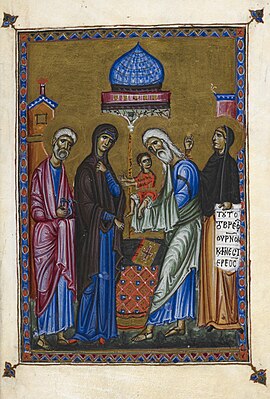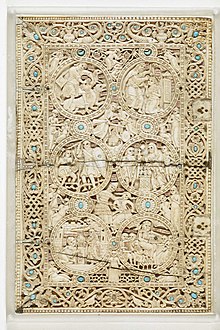Melisende of Jerusalem Queen and Patron of Art and Architecture in the Crusader Kingdom

The Melisende Psalter (London, British Library, Egerton MS 1139) is an illuminated manuscript commissioned around 1135 in the crusader Kingdom of Jerusalem, probably past Rex Fulk for his wife Queen Melisende. It is a notable example of Crusader art, which resulted from a merging of the artistic styles of Roman Cosmic Europe, the Eastern Orthodox Byzantine Empire and the fine art of the Armenian illuminated manuscript.
Seven scribes and illuminators, working in the scriptorium built past the crusaders in the Church of the Holy Sepulchre in Jerusalem, were involved in the creation of the psalter. Information technology measures 21.6 centimetres by 14 centimetres.
This manuscript forms office of the Egerton Collection in the British Library.
The New Attestation cycle [edit]

The first 20-four illustrations (on each side of the starting time twelve folios) describe scenes from the New Testament. New Attestation images were normally found at the beginning of western psalters, unlike in eastern psalters, but in this example the images draw scenes more common in the Eastern Orthodox liturgy. The scenes depicted are the Annunciation, Visitation, the Nativity, the Adoration of the Magi, the Presentation of Jesus at the Temple, the Baptism of Jesus, the Temptation of Christ, the Transfiguration, the Raising of Lazarus, the Triumphal entry into Jerusalem (see illustration), the Terminal Supper, the Washing of the Anxiety, the Agony in the Garden, the Betrayal of Judas, the Crucifixion of Jesus, the Descent from the Cantankerous, the Lamentation, the Harrowing of Hell, the 3 Marys at the Tomb, and the Deesis.
These illustrations were made by an illuminator named Basilius, who signed the concluding illustration (pictured above) Basilius me fecit, and is the only named illuminator or scribe of this manuscript. Nil is known about Basilius, but because of his Greek name information technology has been suggested that he was a Byzantine artist; information technology is also possible that he was a western artist who had been trained in a Greek style, peradventure in Constantinople; or he may have been an Armenian Catholic, familiar with both Catholic and Orthodox traditions.
-

-

Christ's entry into Jerusalem
-

-

The Deesis illumination, folio 12 verso
The agenda [edit]

Folios 13-21 contain the calendar, which is strikingly similar to psalter calendars produced in England in the same period. It appears to exist based on a agenda of St. Swithun's church in Winchester. The agenda is filled with English language saint days rather than those more popular in Jerusalem, and 1 name, St. Martin of Tours, a saint pop throughout Europe, is written in aureate, for unknown reasons. Three crusader-specific dates are mentioned in the agenda: the capture of Jerusalem on July fifteen, the death of Baldwin II on Baronial 21, and the expiry of his married woman Morphia on October 1. Each month as well has a medallion with a sign of the Zodiac, illustrated in a Romanesque fashion with heavy Islamic influences.
The psalter [edit]
Folios 22-196 contain the Latin psalms written in a northern French script. A third illuminator painted the initial letters of each psalm. Some initials take up the entire side of a foliage, and are fatigued with aureate lettering on a purple background. They bear witness influence from Italian and Islamic fine art, possibly suggesting that the artist was trained in Muslim-influenced southern Italia.
Prayers to the saints [edit]
The scribe who wrote the psalms also wrote a series of prayers on folios 197–211, dedicated to nine saints - the Virgin Mary, St. Michael, St. John the Baptist, St. Peter, St. John the Evangelist, St. Stephen, St. Nicholas, St. Mary Magdalene, and St. Agnes. The prayers are accompanied by paintings of the saints by a fourth illuminator trained in a Romanesque style, merely his technique as well shows an attempt to incorporate a Byzantine fashion. There are a few blank and undecorated spaces in this section of the psalter, and it may be incomplete.
The covers [edit]

The ivory covers, decorated with some small turquoise beads, show scenes from the life of King David and from the Psychomachia of Prudentius on the forepart side, and another male monarch performing the Vi Works of Mercy from the Gospel of Matthew on the back side, both showing influence from Byzantine, Islamic, and western art. The geometric designs on the covers are especially influenced past Islamic art. The king on the back side is dressed in Byzantine purple apparel, merely most likely represents a crusader rex, perhaps Fulk. There is a carving of a falcon above him, which is possibly a clue that the rex is Fulk, every bit "falcon" and "Fulk" in Erstwhile French were both "Fouque." Underneath the falcon the name "Herodius" is carved, Latin for Gyrfalcon; although the creative person has not signed in the same fashion Basilius has.
The spine of the psalter is decorated with Byzantine silk and silver thread, as well every bit scarlet, bluish, and green Greek crosses (which are also constitute in the royal arms of the kingdom). The spine was stitched by an artisan who was perhaps a westerner trained in a Byzantine style, as his stitching is non as smooth as other examples of Byzantine silk spines made by native Greeks.
Date and recipient [edit]
The exact date of the psalter, and for whom it was made, is unknown, although it is obviously made for a noble woman of the kingdom, based on the use of Byzantine styles (considered to be "aristocratic" by the crusaders), the depictions of kings, and the use of feminine word endings in the Latin prayers. Through circumstantial evidence Queen Melisende can probably exist identified as the recipient. The English influence in the calendar and elsewhere probable comes from King Fulk, who was related to the English majestic family by marriage. It is also notable that aside from the capture of Jerusalem, the only crusader-specific dates in the calendar are the deaths of Melisende's parents, King Baldwin Ii and Queen Morphia. The mixture of Catholic and Orthodox elements in the psalter may reflect Melisende's mixed upbringing (Baldwin was Cosmic and Morphia was an Armenian of the Greek Orthodox faith).
If Melisende was indeed the recipient, then the psalter was most probable deputed past Fulk, probably effectually 1135. Prior to this, Fulk and Melisende had been fighting for superiority in the kingdom, and Melisende had centrolineal with rebels confronting Fulk; past 1134 they had reconciled, and the psalter had to have been written afterward 1131, the appointment of Baldwin 2'due south death. On the other mitt, information technology could have been written anytime before Melisende's death in 1161. Palaeographical comparisons to other texts produced in Jerusalem suggest information technology was written in the 1140s or even 50s, only the later texts may accept used the Melisende Psalter every bit a source.
The manuscript was perchance endemic by Grande Chartreuse, Grenoble, in the early on 19th century. By virtually 1840 it was owned by Ambroise Comarmond, manager of the Museum of Fine Arts of Lyon. Its next owner was Guglielmo Libri (b. 1802, d. 1869), who is nigh famous for stealing medieval manuscripts from French public libraries; he sold it to the London book dealers Payne and Foss, who in turn sold to the British Museum in November 1845.
In popular culture [edit]
In the historical thou strategy simulation game, Crusader Kings III, the Melisende Psalter is an object the ruler can collect if their spouse or lover is cheating on them, as a reference to Fulk's endeavor to win back Melisende'southward favor with the gift during her affair with Hugh II of Jaffa. It is called 'The Psalter of Cuckoldry', with a description of the detailing of the ivory front and its turquoise chaplet to define the object as the Melisende Psalter.
Sources [edit]
- Janet Backhouse, "The Case of Queen Melisende's Psalter: An Historical Investigation."" In Tributes to Jonathan J. G. Alexander: The Making and Meaning of Illuminated Medieval and Renaissance Manuscripts, Art and Architecture, edited by Susan Fifty'Engle and Gerald B. Invitee, pp. 457-seventy. London: Harvey Miller, 2006.
- Hugo Buchthal, Miniature Painting in the Latin Kingdom of Jerusalem. Clarendon Press, 1957.
- Jaroslav Folda. "Melisende of Jerusalem: Queen and Patron of Art and Compages in the Crusader Kingdom." In Reassessing the Roles of Women as Makers of Medieval Art and Architecture, edited past Therese Martin, pp. 429–477. Leiden; Boston: Brill, 2012.
- Jaroslav Folda, The Art of the Crusaders in the Holy Land, 1098-1187. Cambridge University Press, 1995.
- Bianca Kühnel, Crusader Fine art of the 12th Century - A Geographical, an Historical, or an Fine art Historical Notion? Berlin, 1994.
- Bernard Hamilton, "Women in the Crusader States: The Queens of Jerusalem (1100-1190)." In Medieval Women: Dedicated and Presented to Rosalind M. T. Hill on the Occasion of Her Seventieth Birthday, edited by Derek Bakery, pp. 143-74 (Studies in Church History, Subsidia 1: Oxford, 1978).
- Jonathan Riley-Smith, The Oxford History of the Crusades. Oxford University Press, 2002.
- Barbara Zeitler, "The Distorting Mirror: Reflections on the Queen Melisende Psalter," in Through the Looking Glass: Byzantium Through British Optics. Papers From the Twenty-Ninth Spring Syposium of Byzantine Studies, London, March 1995, eds. Robin Cormack and Elizabeth Jeffreys. Variorum, 2000.
Farther reading [edit]
- Evans, Helen C. & Wixom, William D., The glory of Byzantium: art and civilization of the Heart Byzantine era, A.D. 843-1261, no. 259, 1997, The Metropolitan Museum of Art, New York, ISBN 9780810965072; full text available online from The Metropolitan Museum of Art Libraries
External links [edit]
- Melisende Psalter: data, zoomable prototype British Library website
- British Library Digital Catalogue of Illuminated Manuscripts entry
- British Library Digitized manuscripts site with fully digitised version
lococomaystionite.blogspot.com
Source: https://en.wikipedia.org/wiki/Melisende_Psalter
0 Response to "Melisende of Jerusalem Queen and Patron of Art and Architecture in the Crusader Kingdom"
Post a Comment